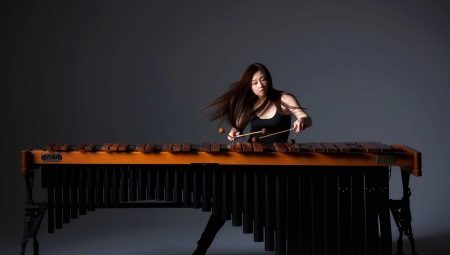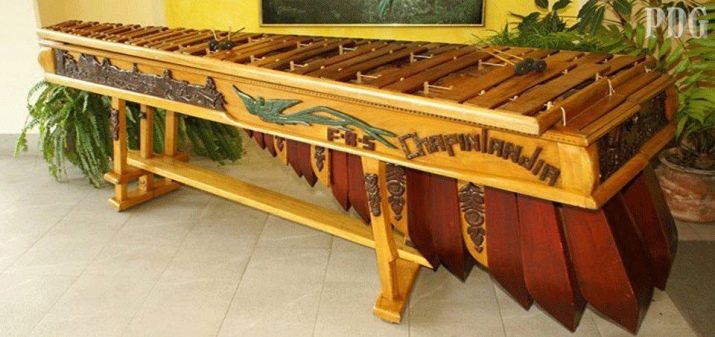Everything you need to know about the marimba

Marimba is a musical instrument from the percussion family, it is distinguished by a pleasant deep timbre and expressive sound. The closest relatives of marimba are the xylophone and vibraphone, they are also played with sticks. It is popularly known as the African organ.


What it is?
Marimba is a percussion instrument, in terms of sound parameters it is close to a xylophone. After its appearance, it quickly spread to Malaysia, North and Central America, as well as Mexico and South Africa. The instrument consists of keys fixed to the frame; they are made of natural wood.



The main difference between xylophone and marimba comes down to sound quality. In the latter, the keys are placed above a powerful resonator; in the past, a pumpkin played its role. Thanks to this, the sound of each plate is timbre increased, becomes soft and spacious.
This makes the melody especially expressive.

In modern practice, playing the marimba involves working with 2–6 sticks at once and even with several performers at once. By choosing the right sticks, the performer can achieve a wide spectrum, from snapping to deep and gentle.

History of origin
To this day, there is no single theory about the origin of this percussion instrument; there are three main versions on this issue. According to the first, marimba appeared in Africa, on the territory of Angola, according to the second, Indonesia became its homeland. Another version says that the marimba appeared in the era of the most ancient Mayan civilization.An archaeological find speaks in favor of the latter theory - it is known that an image of a musical instrument is engraved on a vase obtained during excavations in Ratinlinshul, in its appearance it very much resembles a marimba. Today this exhibit is at the University of Pennsylvania, USA.


Which of the three versions is correct - one can only guess, especially since the appearance of the marimba is surrounded by many legends and traditions. According to the South African epic, once upon a time there lived a beautiful goddess named Marimba. Once she was hanging pumpkins just below the wooden planks and noticed that when struck, they emit an amazingly beautiful melody. It is believed that it was in her honor that the exotic instrument got its unusual name.

According to another legend, a beautiful girl Maryam lived in the distant past. While her close friend was away, she turned into a tree. To preserve the memory of her and always feel his beloved next to him, the young man made a musical instrument out of bark and went with him to travel through the villages and villages, bringing joy to people.
He believed that his beloved Maryam spoke to him through the voice of the instrument.

There is also a third legend. It says that the instrument was created by two boys, who were sent by their parents to the forest for brushwood. All these beautiful legends were formed during the colonial period. On this basis, art historians attribute the origin of this musical instrument to approximately this period of time.

Quite quickly, the marimba became a familiar and close instrument not only for musicians of the hot continent, but also for people living in Mexico, Guatemala and many other states of Latin America. Later, the pumpkin resonators were replaced by wooden ones, and the diatonic tuning was replaced by the chromatic one.

The Latin American marimba became a model for modernization, it was it that the famous acoustician and creator of percussion instruments K. Deegan took for improvement. He significantly changed the ancient musical instrument: changed wood resonators to steel ones, set the standard for tuning and proved that the most successful sound conductor for tone plates would be rosewood. Deegan tried not to limit himself to theoretical research, he largely contributed to the active popularization of the marimba. It is no coincidence that his firm J. C. Deagan, Inc. 2 launched the serial production of this tool for the first time.

Today, Deegan's marimba is recognized as a musical value and a true example of quality. Subsequently, the instrument has undergone some more changes, until now it does not stop improving. In recent years, both its internal and external characteristics have improved significantly, the potential for sound and expressiveness has expanded. From the field of mass ethnic musical culture, the marimba rose to the field of academic art and quickly conquered the whole world.

In the middle of the last century, the instrument first came to Japan and instantly conquered the inhabitants of the Land of the Rising Sun. Famous Japanese composers began to compose pieces of music for him, and even his own Japanese school of marimba was founded. One of the performers - Japanese Keiko Abe - became famous all over the world thanks to her musical skill and technique of playing the marimba.

Nowadays, the instrument is usually used as a solo, less often - for playing in an ensemble. Marimba can be found in American pop music. But in orchestral performance, it is not in demand due to its specific timbre and quiet sound.

Technique of the game
The technique of playing the marimba involves the simultaneous use of several sticks at once. Traditionally used from 2 to 4 sticks, a little less often - 5-6. The instrument can be played simultaneously by several musicians. The acoustic capabilities of the percussion instrument allow you to perform compositions of different types on it: harmony, melodies, as well as lyrical passages.
Modern industry produces several types of sticks of different lengths. They can have plastic, wooden or rubberized tips, traditionally they are wrapped with cotton or woolen threads.
By using different sticks, the performer can achieve a wide range of varied sounds.

The range of the marimba is 4 or 4.3 octaves. In recent decades, improved instruments have appeared, the number of octaves in which is more - up to 6. However, marimbas of this category are rare, they are intended exclusively for playing solo. As a rule, they are made individually to order.

Application in the modern world
In recent decades, academic musicians have been actively using marimba. When performing their compositions, they place the main emphasis on the combination of the sound of the marimba and the vibraphone. It is this tandem that is clearly distinguishable in the melodies of the famous composer from France Darius Millau. Famous musicians such as Nei Rosauro, Toru Takemitsu, Olivier Messiaen, as well as Keiko Abe, Karen Tanaka and Steve Reich played an important role in the spread of the marimba.

The creators of fashionable rock music also often use the atypical sound of an ethnic instrument. So, marimba motives can be found in the hits of famous bands - "Under My Thumb" by the Rolling Stones, "Mamma Mia" by ABBA and in the songs of Freddie Mercury.

In 2011, poet and scholar Jorge Macedo received an award from the Government of Angola for his invaluable contribution to the revival of this ancient percussion instrument. Few people know, but the sounds of marimba are very often heard in call melodies on smartphones, while most of their owners are not even aware of it.

The Russian composer and performer Pyotr Glavatskikh recently recorded an unusual album "Unidentified Sound". In it, he masterfully plays this most original instrument. At one of his concerts, the musician even performed the music of famous Russian composers on the marimba.









